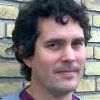
Jotun Hein. Reconstructing evolution of sequences subject to recombination using parsimony. In MBIO, Vol. 98(2):185-200, 1990.
Note: http://dx.doi.org/10.1016/0025-5564(90)90123-G.
Toggle abstract
"The parsimony principle states that a history of a set of sequences that minimizes the amount of evolution is a good approximation to the real evolutionary history of the sequences. This principle is applied to the reconstruction of the evolution of homologous sequences where recombinations or horizontal transfer can occur. First it is demonstrated that the appropriate structure to represent the evolution of sequences with recombinations is a family of trees each describing the evolution of a segment of the sequence. Two trees for neighboring segments will differ by exactly the transfer of a subtree within the whole tree. This leads to a metric between trees based on the smallest number of such operations needed to convert one tree into the other. An algorithm is presented that calculates this metric. This metric is used to formulate a dynamic programming algorithm that finds the most parsimonious history that fits a given set of sequences. The algorithm is potentially very practical, since many groups of sequences defy analysis by methods that ignore recombinations. These methods give ambiguous or contradictory results because the sequence history cannot be described by one phylogeny, but only a family of phylogenies that each describe the history of a segment of the sequences. The generalization of the algorithm to reconstruct gene conversions and the possibility for heuristic versions of the algorithm for larger data sets are discussed. © 1990."
@Article{Hein1990,
AUTHOR = {Hein, Jotun},
TITLE = {Reconstructing evolution of sequences subject to recombination using parsimony},
YEAR = {1990},
JOURNAL = {MBIO},
VOLUME = {98},
NUMBER = {2},
PAGES = {185-200},
URL = {http://dx.doi.org/10.1016/0025-5564(90)90123-G},
NOTE = { http://dx.doi.org/10.1016/0025-5564(90)90123-G},
ANNOTE = {CITE : } } |